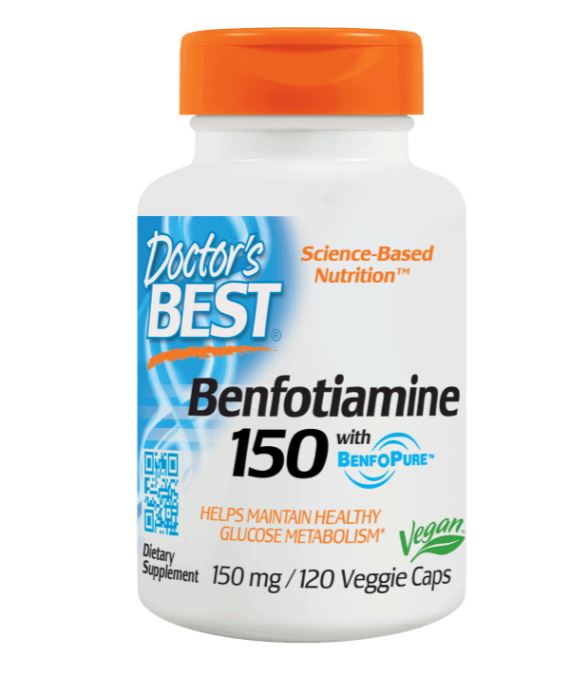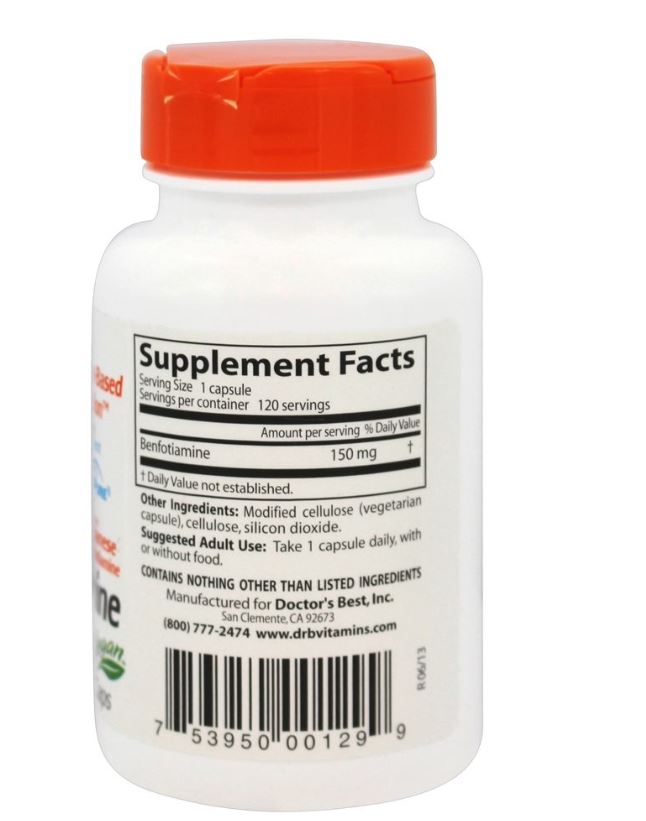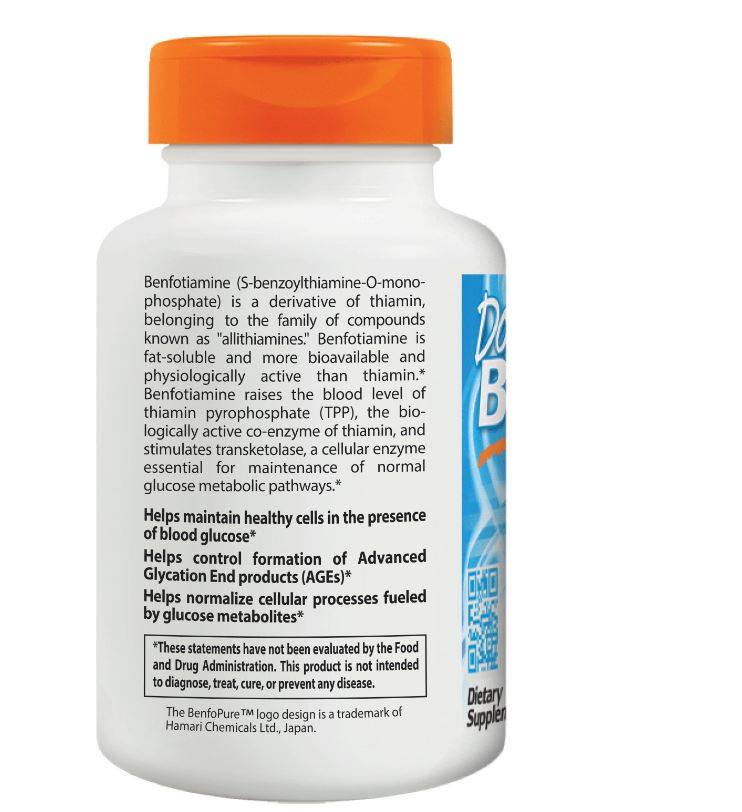Overview
Description
Doctor's Best - Benfotiamine 150 mg. - 120 Vegetarian Capsules
Doctor's Best Best Benfotiamine (S-benzoylthiamine-O-monophosphate) is a synthetic derivative of thiamin, belonging to the family of compounds known as "allithiamines." Benfotiamine is fat-soluble and more bioavailable and physiologically active than thiamin. Benfotiamine raises the blood level of thiamin pyrophosphate (TPP), the biologically active co-enzyme of thiamin, and stimulates transketolase, a cellular enzyme essential for maintenance of normal glucose metabolic pathways. Doctor's Best Best Benfotiamine is suitable for vegetarians.
Features & Benefits:
- Science-based nutrition
- Dietary supplement
- Helps maintain healthy cells in the presence of blood glucose
- Controls formation of Advanced Glycation Endproducts (AGEs)
- Normalizes cellular processes fueled by glucose metabolites
Doctor's Best Best Benfotiamine Ingredient Information
Benfotiamine (S-benzoylthiamine O-monophosphate) is a synthetic derivative of thiamin (vitamin B1) that has been shown in studies to be far more bioavailable than actual thiamin. Benfotiamine taken orally is readily absorbed at higher doses, in sharp contrast to regular water-soluble forms of thiamin that exhibit a rapid decline in absorption when taken in doses above 5 mg. Human and rodent studies indicate that benfotiamine can greatly improve thiamin status, especially in comparison with regular forms of thiamin. In a randomized, double-blind cross-over trial comparing bioavailability of benfotiamine to that of thiamin mononitrate (the most common supplemental form of vitamin B1) in 12 individuals, benfotiamine caused an average 5-fold greater increase in blood thiamin levels than thiaminmononitrate, with a concomitant greater thiamin concentration in red blood cells. Benfotiamine is converted to S-benzoylthiamin (through removal of the O-monophosphate by the digestive tract), which readily passes through intestinal cells and is converted into thiamin.
Support against oxidative stress
Benfotiamine displays direct antioxidant action in vitro, and preliminary research with human subjects suggests that this activity can be advantageous in helping to safeguard the integrity of human DNA by increasing the antioxidant capacity of plasma. In the laboratory, when human, rat, and porcine kidney cells were exposed to toxins that assault the integrity of DNA, benfotiamine was able to reduce oxidative stress under these circumstances. Benfotiamine, like vitamins C and E, can deter the activation of NF-kB (a DNA-binding factor known to be activated by oxidative stress-generated reactive oxygen species) for more balanced immune responses. Furthermore, recent in vitro results suggest that the beneficial antioxidant properties of benfotiamine could work against some forms of lipid peroxidation. An animal model suggests that during oxidative stress generated by excess glucose, benfotiamine has the capacity to reduce levels of superoxide and hydroxyl radicals in the heart. Similarly, an animal model of induced oxidative stress in the cerebral cortex (the outer most layer of the brain) suggests a beneficial antioxidant effect of benfotiamine.
Supports blood levels of thiamin pyrophosphate (TTP), the biologically active co–enzyme form of thiamin
Helps maintain healthy glucose metabolismBenfotiamine increases blood and tissue levels of thiamin pyrophosphate (TPP), the biologically active co-enzyme form of thiamin. TPP acts as a co-enzyme for three critical enzymes involved in glucose metabolism: 1) transketolase, 2) pyruvate dehydrogenase, and 3) a-ketoglutarate decarboxylase. The latter two enzymes are involved in utilizing glucose for fuel. Thus, TTP is vital to the cell’s energy supply.
Stimulates transketolase, a cellular enzyme essential for maintenance of normal glucose metabolic pathwaysSuperoxide, a type of free radical known as a reactive oxygen species (ROS), is a highly toxic molecule produced by our immune system as part of our defense network; in this capacity, it is carefully controlled and works in our favor. However, superoxide is also a byproduct of cellular energy production and other vital processes such as the breakdown of nucleic acids (DNA & RNA) and ATP. It can be produced in quantities beyond our immediate capacity to neutralize, hindering another enzyme involved in the metabolism of glucose, GAPDH. This can lead to a build up of upstream glucose metabolites; in other words, the pathway can get “backed up.” Biological metabolic pathways can be thought of as similar to assembly (or disassembly) lines, where enzymes in the pathway are analogous to steps in the assembly or disassembly of a product. Blocking GAPDH essentially slows the metabolism of glucose, causing a build up of the metabolites being produced up to that point in the process. These glucose metabolites can be safely metabolized by transketolase. However, if transketolase activity is not optimal, some of these metabolites may be diverted to other biochemical pathways, including the production of advanced glycation end-products (AGEs). Benfotiamine can enhance transketolase activity by promoting tissue levels of TPP.
Supports healthy aging
Disrupts formation of Advanced Glycation End-Products (AGEs)
Helps maintain healthy circulationThis benfotiamine enhanced transketolase activity leads to metabolic pathways favoring less production of AGEs. AGEs are formed by a complex series of reactions between reducing sugars and amino acids on proteins, lipids, and nucleic acids. Diet is a major external source of AGEs, with about 10% of AGEs from food remaining in the body after ingestion. Bodily AGE levels are higher in smokers and individuals consuming AGE-rich diets. In food, AGEs are created by a non-enzymatic browning process called the Maillard reaction, which can contribute to desired colors, odors, and tastes (caramelized onions is one example of the reaction’s results). However, this reaction is not restricted to food; in 1981, researchers discovered that the Maillard reaction also takes place within the body, and that it accelerates as we age (hence the term “AGE”). AGEs are especially a concern among long–lived proteins, such as serum albumin, lens crystalline, and collagen in the extracelluar matrix. Internal AGEs may also be formed within cells due to accumulation of super–reactive glucose metabolic intermediates, such as triosephosphates, affecting nearby proteins, lipids, and DNA.
In a crossover study of 13 participants, a test meal with high AGE content was provided before and after 3 days of oral benfotiamine administration at a dose of 1,050 mg. Measurements of endothelial function (behavior of cells lining the blood vessel walls) and oxidative stress were taken on both occasions. The high AGE meal significantly increased TBARS (an indicator of oxidative stress) and impaired circulation—yet these effects of the meal were negated by supplemental benfotiamine when compared to the baseline meal as measured prior to supplementation. Although this study was small and more research is needed, it implies that benfotiamine may help to maintain healthy post-meal circulation. In laboratory animals, benfotiamine has been demonstrated to decrease AGE production in the nerves, kidneys, and retina of the eyes. While these studies are suggestive of an ability of benfotiamine to reduce production of AGEs in humans, this has yet to be strongly demonstrated clinically.
Helps maintain nervous system healthBenfotiamine also has a history of nerve-related research, including a 3-week randomized, double-blinded, placebo-controlled pilot trial of 40 participants. In this short study, the group taking 400 mg benfotiamine daily had superior sensory function and other statistically significant outcome measures pertaining to nerve health. These findings are supported by results from other placebo-controlled trials in which benfotiamine was administered as tablets or capsules in doses ranging from 120 to 600 mg daily (higher doses showed the greatest benefit). In a mouse model, benfotiamine has been shown to support cognitive function.
Suggested Use
One capsule daily, with or without food.
Ingredients
| Doctor's Best - Benfotiamine 150 mg. - 120 Vegetarian Capsules | |||||||||||||||||||||||||||
|
|||||||||||||||||||||||||||
| Other Ingredients: Modified cellulose (vegetarian capsule), cellulose, silicon dioxide | |||||||||||||||||||||||||||
Warnings
Questions & Answers
2 Reviews
Needless to say, after a week or so I quit using. They need to be smoother and actually have the ability to dissolve.




















It works!
Recommended by a friend
trying a new brand of zinc lozenge
Good for colds etc..